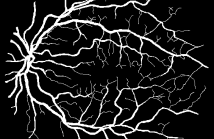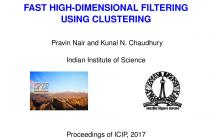
The International Conference on Image Processing (ICIP), sponsored by the IEEE Signal Processing Society, is the premier forum for the presentation of technological advances and research results in the fields of theoretical, experimental, and applied image and video processing. ICIP has been held annually since 1994, brings together leading engineers and scientists in image and video processing from around the world. Visit website.
- Read more about Iterative Fitting After Elastic Registration: An Efficient Strategy for Accurate Estimation of Parametric Deformations
- Log in to post comments
We propose an efficient method for image registration based on iteratively fitting a parametric model to the output of an elastic registration. It combines the flexibility of elastic registration - able to estimate complex deformations - with the robustness of parametric registration - able to estimate very large displacement. Our approach is made feasible by using the recent Local All-Pass (LAP) algorithm; a fast and accurate filter-based method for estimating the local deformation between two images. Moreover, at each iteration we
- Categories:
 11 Views
11 ViewsWith the prevalence of digital products like cellphone, tablet and personal computer, the screen content image (SCI) consisting of text, graphic, and natural scene picture becomes a significant media in various communication scenarios. Consequently, we proposed a reduced-reference quality metric dedicated for SCI.
- Categories:
 6 Views
6 Views
- Read more about Blur Estimation for Photon-Limited Images
- Log in to post comments
Blur estimation is critical to blind image deconvolution. In this work, by taking Gaussian kernel as an example, we propose an approach to estimate the blur size for photon-limited images. This estimation is based on the minimization of a novel criterion, blur-PURE (Poisson unbiased risk estimate), which makes use of the Poisson noise statistics of the measurement. Experimental results demonstrate the effectiveness of the proposed method in various scenarios.
- Categories:
 39 Views
39 Views- Read more about VISUAL AND TEXTUAL SENTIMENT ANALYSIS USING DEEP FUSION CONVOLUTIONAL NEURAL NETWORKS
- Log in to post comments
Sentiment analysis is attracting more and more attentions and has become a very hot research topic due to its potential applications in personalized recommendation, opinion mining, etc. Most of the existing methods are based on either textual or visual data and can not achieve satisfactory results, as it is very hard to extract sufficient information from only one single modality data.
- Categories:
 21 Views
21 Views- Read more about Context-Based Occlusion Detection for Robust Visual Tracking
- Log in to post comments
Occlusion is one of the most challenging factors in visual tracking. In this paper, we propose a novel context-based occlusion detection algorithm for robust visual tracking. The basic idea of our algorithm is that occlusion indicates that
- Categories:
 30 Views
30 Views
- Read more about Patch-based Fully Convolutional Neural Network With Skip Connections For Retinal Blood Vessel Segmentation
- Log in to post comments
Automated segmentation of retinal blood vessels plays an important role in the computer aided diagnosis of retinal diseases. The paper presents a new formulation of patch-based fully Convolutional Neural Networks (CNNs) that allows accurate segmentation of the retinal blood vessels. A major modification in this retinal blood vessel segmentation task is to improve and speed-up the patch-based fully CNN training by local entropy sampling and a skip CNN architecture with class-balancing loss.
icip2017.pdf
- Categories:
 87 Views
87 Views- Read more about A General Form of Illumination-Invariant Descriptors in Variational Optical Flow Estimation
- Log in to post comments
- Categories:
 34 Views
34 Views- Read more about STEREO AMBIGUITY INDEX FOR SEMI-GLOBAL MATCHING
- Log in to post comments
Stereoscopic reconstruction is important to automatic vision systems. As an intermediate step, estimating this reconstruction is not enough for good performance of the whole system, and its uncertainty must be characterized. Several methods propose uncertainty indexes based on specific data features, thus incomplete, while others are based on learning. We propose a simple index, named ambiguity index, taking into account both data and regularization, and derived directly from the optimization process.
- Categories:
 2 Views
2 Views- Read more about MULTI-PART COMPACT BILINEAR CNN FOR PERSON RE-IDENTIFICATION
- Log in to post comments
poster.pdf
- Categories:
 4 Views
4 Views
Several algorithms in image processing involve spatio-range filtering of images and high-dimensional data derived from them. The exact computation of these so-called high-dimensional filters is challenging, especially for real-time processing of high-resolution images. In this paper, a simple yet accurate approximation of high-dimensional filters is obtained using a mix of clustering and fast convolutions. The resulting algorithm is competitive with state-of-the-art methods and importantly comes with guaranteed error bounds. The algorithm will be discussed in short in this presentation.
- Categories:
 27 Views
27 Views